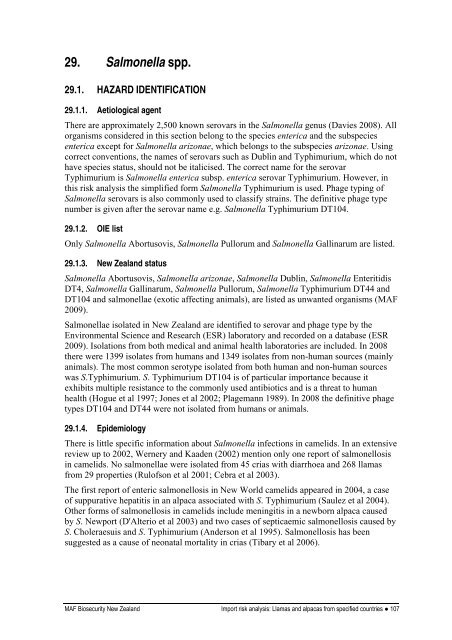Import risk analysis: Llamas (Lama glama) and alpacas (Vicugna ...
Import risk analysis: Llamas (Lama glama) and alpacas (Vicugna ...
Import risk analysis: Llamas (Lama glama) and alpacas (Vicugna ...
Create successful ePaper yourself
Turn your PDF publications into a flip-book with our unique Google optimized e-Paper software.
29. Salmonella spp.<br />
29.1. HAZARD IDENTIFICATION<br />
29.1.1. Aetiological agent<br />
There are approximately 2,500 known serovars in the Salmonella genus (Davies 2008). All<br />
organisms considered in this section belong to the species enterica <strong>and</strong> the subspecies<br />
enterica except for Salmonella arizonae, which belongs to the subspecies arizonae. Using<br />
correct conventions, the names of serovars such as Dublin <strong>and</strong> Typhimurium, which do not<br />
have species status, should not be italicised. The correct name for the serovar<br />
Typhimurium is Salmonella enterica subsp. enterica serovar Typhimurium. However, in<br />
this <strong>risk</strong> <strong>analysis</strong> the simplified form Salmonella Typhimurium is used. Phage typing of<br />
Salmonella serovars is also commonly used to classify strains. The definitive phage type<br />
number is given after the serovar name e.g. Salmonella Typhimurium DT104.<br />
29.1.2. OIE list<br />
Only Salmonella Abortusovis, Salmonella Pullorum <strong>and</strong> Salmonella Gallinarum are listed.<br />
29.1.3. New Zeal<strong>and</strong> status<br />
Salmonella Abortusovis, Salmonella arizonae, Salmonella Dublin, Salmonella Enteritidis<br />
DT4, Salmonella Gallinarum, Salmonella Pullorum, Salmonella Typhimurium DT44 <strong>and</strong><br />
DT104 <strong>and</strong> salmonellae (exotic affecting animals), are listed as unwanted organisms (MAF<br />
2009).<br />
Salmonellae isolated in New Zeal<strong>and</strong> are identified to serovar <strong>and</strong> phage type by the<br />
Environmental Science <strong>and</strong> Research (ESR) laboratory <strong>and</strong> recorded on a database (ESR<br />
2009). Isolations from both medical <strong>and</strong> animal health laboratories are included. In 2008<br />
there were 1399 isolates from humans <strong>and</strong> 1349 isolates from non-human sources (mainly<br />
animals). The most common serotype isolated from both human <strong>and</strong> non-human sources<br />
was S.Typhimurium. S. Typhimurium DT104 is of particular importance because it<br />
exhibits multiple resistance to the commonly used antibiotics <strong>and</strong> is a threat to human<br />
health (Hogue et al 1997; Jones et al 2002; Plagemann 1989). In 2008 the definitive phage<br />
types DT104 <strong>and</strong> DT44 were not isolated from humans or animals.<br />
29.1.4. Epidemiology<br />
There is little specific information about Salmonella infections in camelids. In an extensive<br />
review up to 2002, Wernery <strong>and</strong> Kaaden (2002) mention only one report of salmonellosis<br />
in camelids. No salmonellae were isolated from 45 crias with diarrhoea <strong>and</strong> 268 llamas<br />
from 29 properties (Rulofson et al 2001; Cebra et al 2003).<br />
The first report of enteric salmonellosis in New World camelids appeared in 2004, a case<br />
of suppurative hepatitis in an alpaca associated with S. Typhimurium (Saulez et al 2004).<br />
Other forms of salmonellosis in camelids include meningitis in a newborn alpaca caused<br />
by S. Newport (D'Alterio et al 2003) <strong>and</strong> two cases of septicaemic salmonellosis caused by<br />
S. Choleraesuis <strong>and</strong> S. Typhimurium (Anderson et al 1995). Salmonellosis has been<br />
suggested as a cause of neonatal mortality in crias (Tibary et al 2006).<br />
MAF Biosecurity New Zeal<strong>and</strong> <strong>Import</strong> <strong>risk</strong> <strong>analysis</strong>: <strong>Llamas</strong> <strong>and</strong> <strong>alpacas</strong> from specified countries ● 107

















